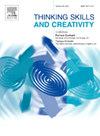Teaching and learning creativity in management: Literature review and a research agenda
IF 3.7
2区 教育学
Q1 Social Sciences
引用次数: 0
Abstract
Purpose
To identify the characteristics of scientific literature, regarding teaching and learning creativity in higher education in the light of the systemic model of creativity as defined by Cszikszentmihalyi.
Methodology
This is a systematic review characterized by a mixed sequential exploratory review, with a transversal approach of descriptive literature, instrumentalized through bibliographic research, whose sampling was of the non-probabilistic, intentional type.
Findings
it is possible to identify, three dimensions of creativity: individual, domain and culture, and the most notable, the field, configured by the school element / environment and the relationships between student and teacher. The second most relevant dimension is that of the individual. The influence of the personality and the relational aspect of the individual is outstanding, translated by family ties in the analytical categories. In the culture/domain dimension, it was observed that there is a low production of studies that consider the influence of the cultural aspect in teaching creativity in higher education. It was found that, in the selected sample, only one study addressed the teaching and learning of creativity within the scope of the undergraduate management course, which indicates low interest in such studies.
Research limitations/implications
the systemic model of creativity was significant to enlighten the analysis of teaching creativity in higher education. There is little research focusing on teaching creativity in management.
Practical implications
undergraduate management courses willing to teach creativity as a necessary competency to foster innovation in organizations will benefit from knowing that it requires new teaching methods that connect the individual, the domain and the field in a systemic approach.
Originality/value
This study contributes to expanding the discussion of teaching and learning creativity in higher education, more specifically in the management area.
管理中的教学与学习创造力:文献回顾与研究议程
目的从Cszikszentmihalyi的创造性系统模型出发,探讨高等教育中教与学创造性的科学文献特征。这是一项系统综述,其特点是混合顺序探索性综述,采用描述性文献的横向方法,通过书目研究进行工具化,其抽样是非概率的,有意的类型。发现可以确定创造力的三个维度:个人、领域和文化,以及最值得注意的领域,由学校元素/环境和学生与教师之间的关系构成。第二个最相关的维度是个人。人格和个人关系方面的影响是突出的,通过分析类别中的家庭关系来翻译。在文化/领域维度,我们观察到,考虑文化方面对高等教育教学创造力影响的研究很少。我们发现,在所选择的样本中,只有一项研究涉及本科管理课程范围内的创造力教与学,这表明人们对这类研究的兴趣不高。研究局限与启示创新系统模型对分析高等教育教学创新具有重要的启示意义。很少有研究关注管理创造力的教学。如果本科管理课程愿意将创造力作为一种必要的能力来教授,以促进组织的创新,那么它需要新的教学方法,以一种系统的方法将个人、领域和领域联系起来,这将使这些课程受益。原创性/价值本研究有助于扩大高等教育中关于教学和学习创造力的讨论,特别是在管理领域。
本文章由计算机程序翻译,如有差异,请以英文原文为准。
求助全文
约1分钟内获得全文
求助全文
来源期刊

Thinking Skills and Creativity
EDUCATION & EDUCATIONAL RESEARCH-
CiteScore
6.40
自引率
16.20%
发文量
172
审稿时长
76 days
期刊介绍:
Thinking Skills and Creativity is a new journal providing a peer-reviewed forum for communication and debate for the community of researchers interested in teaching for thinking and creativity. Papers may represent a variety of theoretical perspectives and methodological approaches and may relate to any age level in a diversity of settings: formal and informal, education and work-based.
 求助内容:
求助内容: 应助结果提醒方式:
应助结果提醒方式:


